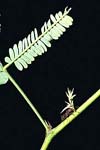The Desert Leafcutter Ant is a member of the family Formicidae. These familiar insects, less than 1/16-1" (1-15 mm) long, are mostly black, brown, or reddish.

- They have a complex social structure usually consisting of a wingless worker caste composed entirely of sterile females and a reproductive caste made up of winged, fertile males and females.
- But some species do not have a worker caste, and some reproductives do not have wings. Ants have a slender "waist," or pedicel, of 1 or 2 beadlike or scalelike segments between the thorax and abdomen. They differ from wasps in having distinctly elbowed antennae.
- Ants live in colonies in underground tunnels or in galleries in dead wood. From time to time, winged males and females emerge from the nest and perform a brief mating flight. After mating, the males die, and the females lose their wings and return to the ground to start a new colony. Workers gather food, maintain and defend the nest, and tend eggs, larvae, and pupae.
- Most species are predators or scavengers, but a few harvest seeds, visit clusters of aphids to eat their sweet secretions, raise fungus for food in small underground gardens, or eat leaves cut from plants. Some species produce eggs, which are eaten by the queen and workers. When disturbed, most ants are capable of "biting" or "stinging" people.
© Copyright Apestcontrol.com 2025



